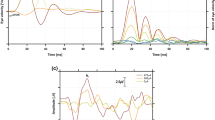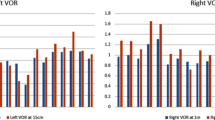Abstract
The angular vestibulo-ocular reflex (AVOR) normally has an increased response during vergence on a near target. Some lines of evidence suggest that different vestibular afferent classes may contribute differentially to the vergence effect. For example, lesions that selectively affect those afferents sensitive to acceleration, i.e. irregular afferents, (galvanic ablation, intratympanic gentamicin) have been found to markedly reduce the vergence-mediated modulation of the AVOR. We hypothesized that a nonspecific and incomplete reduction in the AVOR response caused by canal plugging should have minimal effect on vergence-mediated modulation of the AVOR. The AVOR response to passive head impulses in canal planes (horizontal canals, left anterior-right posterior canals, right anterior-left posterior canals) while viewing a far (124 cm) or near (15 cm) target was measured in seven human subjects before and after anterior canal (AC) plugging to treat vertigo caused by dehiscence of the AC (i.e. superior canal dehiscence). The impulses were low amplitude (∼20°), high velocity (∼150°/s), high-acceleration (∼3,000°/s2) head rotations administered manually by the investigator. Binocular eye and head velocity were recorded using the scleral search coil technique. The AVOR gain was defined as inverted eye velocity divided by head velocity. Before plugging, AVOR gain for the dehiscent AC went from 0.87 ± 0.10 for far targets to 1.04 ± 0.13 for near targets (+19.1 ± 7.3%). After plugging, the AC AVOR gain went from 0.50 ± 0.10 for far targets to 0.59 ± 0.11 for near targets (+19.7 ± 6.1%). There was no difference in the vergence-mediated gain increase between pre- and post-plugged conditions (multi-way analysis of variance: P = 0.66). AC plugging also did not change the latency of the AVOR for either AC. We hypothesize that canal plugging, unlike gentamicin or galvanic ablation, has no effect on vergence-mediated modulation of the AVOR because plugging does not preferentially affect irregular afferents.



Similar content being viewed by others
References
Aw ST, Haslwanter T, Halmagyi GM, Curthoys IS, Yavor RA, Todd MJ (1996) Three-dimensional vector analysis of the human vestibuloocular reflex in response to high-acceleration head rotations. I. Responses in normal subjects. J Neurophysiol 76:4009–4020
Aw ST, Todd MJ, McGarvie LA, Migliaccio AA, Halmagyi GM (2003) Effects of unilateral vestibular deafferentation on the linear vestibulo-ocular reflex evoked by impulsive eccentric roll rotation. J Neurophysiol 89:969–978
Bronstein AM, Hood JD (1986) The cervico-ocular reflex in normal subjects and patients with absent vestibular function. Brain Res 373:399–408
Busettini C, Miles FA, Schwarz U, Carl JR (1994) Human ocular responses to translation of the observer and of the scene: dependence on viewing distance. Exp Brain Res 100:484–494
Carey JP, Migliaccio AA, Minor LB (2007) Semicircular canal function before and after surgery for superior canal dehiscence. Otol Neurotol 28:356–364
Carl JR, Gellman RS (1987) Human smooth pursuit: stimulus-dependent responses. J Neurophysiol 57:1446–1463
Chen-Huang C, McCrea RA (1998) Contribution of vestibular nerve irregular afferents to viewing distance-related changes in the vestibulo-ocular reflex. Exp Brain Res 119:116–130
Crane BT, Demer JL (1998) Human horizontal vestibulo-ocular reflex initiation: effects of acceleration, target distance, and unilateral deafferentation. J Neurophysiol 80:1151–1166
Crane BT, Viirre ES, Demer JL (1997) The human horizontal vestibulo-ocular reflex during combined linear and angular acceleration. Exp Brain Res 114:304–320
Cremer PD, Halmagyi GM, Aw ST, Curthoys IS, McGarvie LA, Todd MJ, Black RA, Hannigan IP (1998) Semicircular canal plane head impulses detect absent function of individual semicircular canals. Brain 121:699–716
Cremer PD, Minor LB, Carey JP, Della Santina CC (2000) Eye movements in patients with superior canal dehiscence syndrome align with the abnormal canal. Neurology 55:1833–1841
Diggle PJ, Liang KY, Zeger SL (1994) Analysis of longitudinal data. Oxford University Press, New York
Halmagyi GM, Curthoys IS (1988) A clinical sign of canal paresis. Arch Neurol 45:737–739
Halmagyi GM, Curthoys IS, Cremer PD, Henderson CJ, Todd MJ, Staples MJ, D’Cruz DM (1990) The human horizontal vestibulo-ocular reflex in response to high-acceleration stimulation before and after unilateral vestibular neurectomy. Exp Brain Res 81:479–490
Halmagyi GM, Curthoys IS, Colebatch JG, Aw ST (2005) Vestibular responses to sound. Ann N Y Acad Sci 1039:54–67
Haslwanter T (1995) Mathematics of three-dimensional eye rotations. Vision Res 35:1727–1739
Hepp K (1990) On Listing’s law. Commun Math Phys 132:285–295
Hirvonen TP, Minor LB, Hullar TE, Carey JP (2005) Effects of intratympanic gentamicin on vestibular afferents and hair cells in the chinchilla. J Neurophysiol 93:643–655
Hullar TE, Della Santina CC, Hirvonen T, Lasker DM, Carey JP, Minor LB (2005) Responses of irregularly discharging chinchilla semicircular canal vestibular-nerve afferents during high-frequency head rotations. J Neurophysiol 93:2777–2786
Igarashi M (1967) Dimensional study of the vestibular apparatus. Laryngoscope 77:1806–1817
Migliaccio AA, Todd MJ (1999) Real-time rotation vectors. Australas Phys Eng Sci Med 22:73–80
Migliaccio AA, Minor LB, Carey JP (2004) Vergence-mediated modulation of the human horizontal vestibulo-ocular reflex is eliminated by a partial peripheral gentamicin lesion. Exp Brain Res 59:92–98
Migliaccio AA, Della Santina CC, Carey JP, Minor LB, Zee DS (2006) The effect of binocular eye position and head rotation plane on the human torsional vestibuloocular reflex. Vision Res 46:2475–2486
Paige GD (1989) The influence of target distance on eye movement responses during vertical linear motion. Exp Brain Res77:585–993
Paige GD, Tomko DL (1991) Eye movement responses to linear head motion in the squirrel monkey. II. Visual-vestibular interactions and kinematic considerations. J Neurophysiol 65:1183–1196
Rabbitt RD, Boyle R, Highstein SM (2001) Physiology of the semicircular canals after surgical plugging. Ann N Y Acad Sci 942:274–286
Schubert MC, Das V, Tusa RJ, Herdman SJ (2004) Cervico-ocular reflex in normal subjects and patients with unilateral vestibular hypofunction. Otol Neurotol 25:65–71
Schwarz U, Miles FA (1991) Ocular responses to translation and their dependence on viewing distance. I. Motion of the observer. J Neurophysiol 66:851–864
Snyder LH, King WM (1992) Effect of viewing distance and location of the axis of head rotation on the monkey’s vestibuloocular reflex. I. Eye movement responses. J Neurophysiol 67:861–874
Straumann D, Zee DS, Solomon D, Lasker AG, Roberts DC (1995) Transient torsion during and after saccades. Vision Res 35:3321–3334
Telford L, Seidman SH, Paige GD (1998) Canal–otolith interactions in the squirrel monkey vestibulo-ocular reflex and the influence of fixation distance. Exp Brain Res 118:115–125
Tychsen L, Lisberger SG (1986) Visual motion processing for the initiation of smooth-pursuit eye movements in humans. J Neurophysiol 56:953–968
Zhou W, Xu Y, Simpson I, Cai Y (2007) Multiplicative computation in the vestibulo-ocular reflex (VOR). J Neurophysiol 97:2780–2789
Acknowledgements
Supported by NIDCD grants RO3 DC007346 to Americo A. Migliaccio; R01 DC02390 to Lloyd B. Minor; K23 DC00196, R03 DC005700 and R01 DC005040 to John P. Carey; Nancy B. Smith and C. Matthew Stewart assisted in the eye movement recordings.
Author information
Authors and Affiliations
Corresponding author
Rights and permissions
About this article
Cite this article
Migliaccio, A.A., Minor, L.B. & Carey, J.P. Vergence-mediated modulation of the human angular vestibulo-ocular reflex is unaffected by canal plugging. Exp Brain Res 186, 581–587 (2008). https://doi.org/10.1007/s00221-007-1262-z
Received:
Accepted:
Published:
Issue Date:
DOI: https://doi.org/10.1007/s00221-007-1262-z




